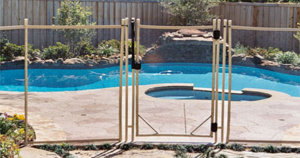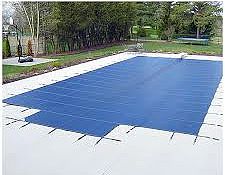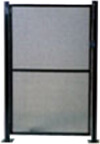FREE Standard Shipping On All Orders $100 or More!*
Pool Safety Cover Vs. Safety Net Vs. Safety Fencing
If you have small children in the house, or soon will - having an open pit of water in the backyard can be downright scary. Pool safety is listed among the top concerns about pool ownership, along with maintenance. Door alarms, barriers, pool alarms, and supervision, swim lessons, strong pool rules - all make safer kids. Today, we focus on pool barriers - one of the best ways to improve pool safety, with solid barriers to entry.
There are many types of pool barriers, including outdoor fireplaces and kitchens, decorative walls or cabanas, neat hedges or thorny bushes, fences, pool covers, and safety nets. The easiest and most economical to install are usually pool fencing, pool covers and safety nets.
Pool Safety Fencing

A pool fence is required just about everywhere, but on some pools it may be just a 3-sided fence that adjoins the house, or the fence may have been taken down, after the pre-opening inspections were approved.
A 4-sided fence, of aluminum or mesh panels, is the safest type of pool fence. Most codes specify that a pool fence must be 4 or 5 feet tall, be non-climbable (without cross rails that give a toe-hold), and have no gaps over 4 inches, between or below the slats.
Mesh pool fencing is an attractive, see-thru pool fencing that meets all safety codes, and can be installed for under $10 per linear foot, by the homeowner, or your local handyman. It's often called removable pool fencing, because an adult can remove the fence sections, to open up the pool for a party, or when kids are older and out of harm's way.
Mesh pool fencing sections start at $90 for a 10 ft section. Installation requires a core drill or hammer drill with drill guide rental, for concrete pool decks. A complete surround may not be needed, if other physical barriers or landscaping features are available.
Pool Safety Covers

Even safer than a safety pool fence is a safety pool cover. These stretch drum tight across the pool, and are anchored into the pool deck. Completely non-removable by children, it can support the weight of a 4000 lb car, so it will support any small child (and large dogs, too).
Traditionally, safety covers are used as winter covers, although they can also be used during the summer, if you are patient and diligent enough to remove and replace the cover, which can take 5-15 minutes, depending on the size and shape of the cover.
Pool safety covers cost about $1.25 per square foot for rectangle stock covers, or about $3.00 per square foot for custom shaped pools. Installation requires a hammer drill rental to install the pool deck anchors.
Automatic pool covers are also a super safe pool barrier because they cover the pool itself, not just the area around the pool. They also save heat loss and prevent evaporation, while keeping the pool clean! Auto covers (as I call them) float on the water surface and can hold the weight of your entire family, although they must have rained water pumped off to be completely safe. Automatic covers are the most convenient cover option, but also the most expensive. Installation is not DIY friendly, and can run $8-12K for complete systems, or $4-7K for manually operated "auto" covers.
Pool Safety Nets
There are several firms that manufacture pool safety nets, each with a national network of installers, usually pool service companies. Safety nets are lightweight and can be removed in under 5 minutes, and put back on the pool in under ten.
A central tension device allows the pool owner to pull the safety net taut, making it trampoline tight. Discreet anchors are recessed into the deck and do not require movement or action from you. Pool safety nets average $1500-$2500, depending on the pool shape and size, including installation.
Pool Safety Covers Vs. Pool Safety Fence Vs. Pool Safety Nets
They all have advantages, and also have limitations or disadvantages. Safety covers, auto covers, and net covers are all very safe - when they are on the pool. Problem is - you have to diligently remember to replace the cover (completely) after using the pool. Even in the dark, or the rain, or when the kids are already in bed and you have other things to do. If it's not on the pool, it's not protecting the children.
Safety fences are inherently safer, because you do not have to remove it to use the pool, just go through the gate. The gate however, is the weak link in the chain, and more than one drowning has occurred from a gate left open, or latched improperly. And, 4' fences, or even 5' fences can be climbed over by an (overly) active child who moves a chair or ladder up against the fence.
Cost
The price of pool safety is not usually the main driver, but for the sake of comparison, what do safety pool nets cost, and how does it compare to the price for a mesh pool fence installation? The cost to install a custom fitted pool safety net is about $1900, according to two similar quotes she got from local pool safety net installers. Whereas pool nets just cover the pool, the cost to install a removable mesh safety fence can vary depending on how much pool deck space you enclose.
So the cost of pool safety nets and pool safety fences are pretty close - although for your pool you may find that prices may vary by several hundred to a thousand dollars, depending on size, options and local market pricing. However, let's compare apples to apples here. The price of $2000 includes installation for the pool net, but not for the pool fence. Installation of a pool safety fence by a local company could add another $500-$1000, depending on size and local market pricing.
Convenience
No doubt about it, having to remove and replace a pool safety net is a bit inconvenient, whenever you want to use the pool, or clean the pool. Removable mesh pool fence is called removable because you can remove it during winter when the safety cover takes it place, or it can be removed temporarily for large events or parties, or removed permanently when children are grown. But a child cannot remove the fence posts. Pool safety nets will take about 5 minutes to remove, and 10 minutes to re-install, and can be done by one person. No more than an hour per week, if you do it four times weekly. However, the scary possibility exists that the cover may not be re-installed immediately, or perhaps not completely re-installed, leaving the pool unprotected.
Compliance
In southeast Texas, the height requirement for a pool fence is 4 ft, but other towns require a 5 ft high fence. If your exterior perimeter fence meets height and other requirements (which it probably does), then a mesh pool fence of 4 ft can be installed. 5 ft tall mesh pool fencing is available, but at a higher cost than priced out above.
In most towns and cities, a pool safety net cannot be used in lieu of, or instead of a pool fence, but as long as your exterior perimeter fence meets code requirements, a pool safety net will only add to your pool safety.
Effectiveness
Which is more effective at preventing access to the pool, a pool net or pool fence? The pool net, when properly installed, is very tight across the pool, and over the pool deck. Without first releasing tension, it's nearly impossible to remove a pool safety net, and therefore nearly impossible to gain access to the pool. The 3-4 inch weave is big enough to get a hand into, for testing temperature or for water testing, but otherwise impenetrable.

The mesh pool fence is made of smooth non-climbable nylon panels, and super rigid poles that won't bend. Children generally cannot reach the latch between fence sections or the gate latch, and if they could, most do not have the hand strength to open the latch. However, the pool fence is not quite as impenetrable as the pool net. If a particularly 'active' child were to move a ladder or chair next to the pool, or scale an overhanging tree branch, climbing over the fence is a scary possibility.
The pool safety net or pool safety fence are both quite effective, but there still exists the possibility of human failure, if the pool net is not replaced immediately, or if the pool fence gate is not closed, or panel sections are left open and unattached, neither safety barrier is effective.
Installation
Pool safety nets require dealer installation, there is no DIY option currently. Pool safety fencing can be done DIY, drilling with a hammer drill and a drill guide (to drill holes at precise angles). A core drill can also be used on concrete pool decks. I've installed a few pool safety fences before. It's similar to installing a pool safety cover, only not as many holes, and you should use a drill guide (or use a core drill), or else the posts may not all line up in a neat and straight row.
The installation of a pool safety net involves drilling brass anchors into the pool deck about every 2 feet, all the way around the pool. The safety net is then stretched over the pool, and attached to the anchors snugly, and the excess net material is trimmed away. The tensioner device is installed to pull several ropes, which cinch up the center of the 'web' and draws the pool net cover drum tight over the pool.
As they say - there is no substitute for proper adult supervision around a swimming pool - and there is no perfect safety solution for swimming pools, they all require a certain level of vigilance and come with their share of responsibility.